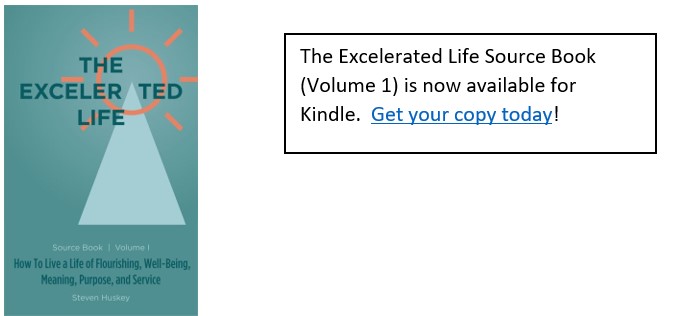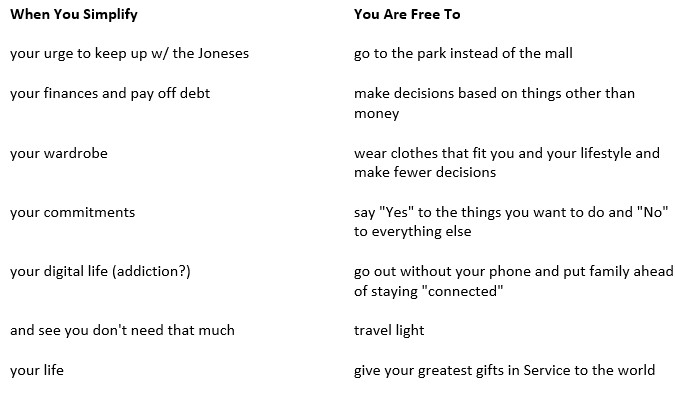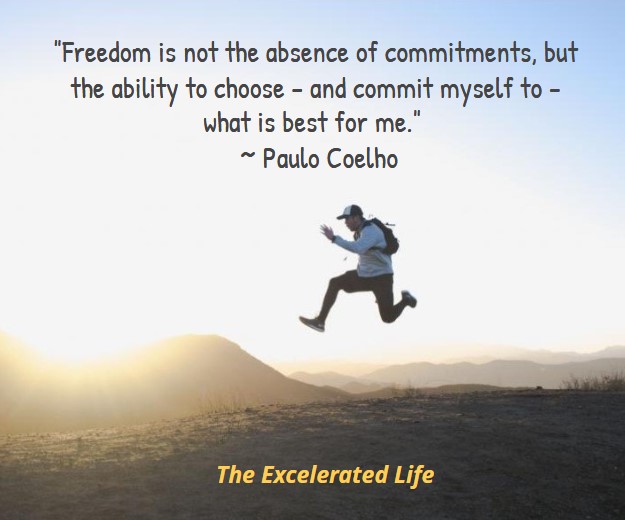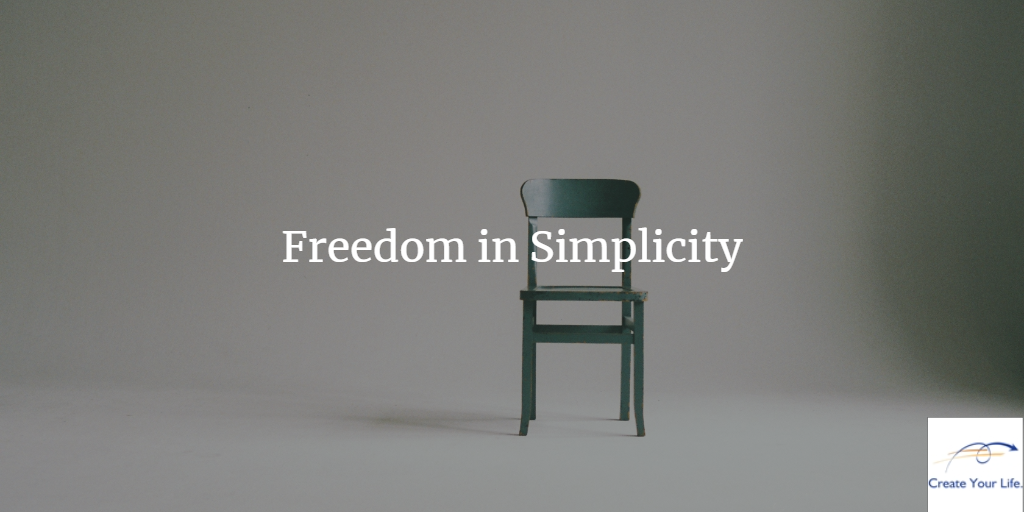Simplicity is a discipline. It requires external action but the initial motivation is internal. Simplicity requires us to choose a course and then take action. It involves cutting out all the noise, the unimportant things, so you have the wherewithal to focus on the important things in life, such as relationships, taking care of yourself, and giving your best in Service to the world.
Too Much Stuff!
Katy was fed up with stuff. Everywhere she looked, there was stuff. Piles of unopened mail and unread papers stood on the table by the door. Folders and notes and “to-do” lists covered her desk. Her cabinets and countertops were filled with cookware and specialty utensils she never used. Her closets were brimming with clothes, yet she never seemed to have anything she wanted to wear. She didn’t have a junk drawer . . . she had four or five. Katy decided she’d had enough. She had read about minimalism and decided that was the lifestyle she wanted to adopt.
So she got busy, simplifying and paring down her possessions. Katy had read about keeping no more than twenty or thirty items in her closet, so she carried most of her clothing and shoes to the local Goodwill collection site. She sold or gave away all of the specialized cooking tools filling her cabinets. Another article she’d read challenged her to have one or two empty drawers in her house to give her “a feeling of spaciousness”. So she dumped out the junk drawers and threw away most of the items in them. She cleaned off her desktop, filed all the papers she wanted to keep, and shredded the rest. She did the same with the many weeks’ worth of mail. It took her over two weeks to get everything in order but once she was finished, she felt free and unencumbered for the first time in years.
For about a week. Then reality set in. Katy realized the thirty items she’d kept in her closet didn’t include a blouse that matched the dress pants she’d kept and which she needed for an important presentation at work. She’d also somehow given away the holiday platter she now wished she had kept for a dish to take to a party she’d been invited to. And when she started searching for an important tax document that was not in the folder she thought she had placed it in, she found it – or pieces of it – in the shredder! Katy decided that maybe minimalism was not for her. “I guess I’m not cut out for a simple life,” she said to herself.

What Is Simplicity?
Our friend Katy jumped into simplifying her life without first thinking through what a simpler life might look like for her. She took an incomplete vision of simplicity formed from reading a few articles and tried to use that as the blueprint with less than satisfying results.
Simplicity is not simplism, which is oversimplification. [Foster] “Things should be made as simple as possible,” goes the saying, “but no simpler.”
Simplicity is not just a lifestyle. It’s a discipline. It requires external action but the initial motivation is internal. [Audet] Simplicity requires us to choose a course and then take action. [Foster] It involves cutting out all the noise, the unimportant things, so you have the wherewithal to focus on the important things in life, such as relationships, taking care of yourself, and giving your best in Service to the world.
And, as our friend Katy must learn, “simplicity looks different for everyone” [“How Simplicity Provides Freedom”] It may mean having less of everything: articles, choices, demands on our resources of time, energy, and money. It often means being “well-enough” organized, able to find what you need when you need it. Importantly, simplicity means whatever you need to feel less stressed, more together, better organized, more freedom from clutter and less searching for things you need, fewer lost papers and unpaid bills.
Simplicity vs. Minimalism
“I am not a minimalist. But I do like things simple.” [Audet]
Minimalism and simplicity share some commonalities but they are not the same thing.
Minimalism is more of an ideology and an identity. It is a mindset of approaching life with less clutter, fewer possessions, minimal distractions. Minimalism requires that you own only the essentials, no extras.
Simplicity is more a state of mind than a set of specific practices. It has similar goals as minimalism – more time, better organization. But simplicity is not so focused on cutting down to the bare minimum.
As Katy mulled over her experience, she realized that she had been aiming for a minimalist life but that wasn’t really her goal. She wanted less clutter and fewer things to deal with, but that didn’t mean cutting her possessions to bare bones in order to simplify her life.
Freedom In Simplicity
Here is a table, adapted from the blog post “Simplicity Is Freedom” by Courtney Carver, detailing some of the freedoms to be enjoyed when you simplify your life.

Of course, freedom in simplicity does not mean there will never be difficulties. Sometimes, it may even seem more difficult because you are stepping away from the norm of consumer culture. But the benefits you receive, the lightening of the load, the freedom, make it all worthwhile.

Simplicity and Contentment
Simplicity and contentment go hand-in-hand. As you learn to simplify your life, your desire for new and bigger things wanes and your contentment with what you have grows. And as you become more and more content with your simpler life, you’ll look for more ways to simplify, creating a virtuous circle.
Keep in mind that simplicity and simplifying don’t mean you stop dreaming or setting BIG goals, but you can practice contentment with where you are while continuing to strive toward your goal.
For example, your goal may be to become debt-free and financially independent, which could be a really long-range commitment. But you can track where you are and see the progress you’ve made and let that be OK. Celebrate what you’ve accomplished even as you continue to work toward your end goal.
Choosing Simplicity
Katy still longed for the freedom and the contentment that she envisioned in living a simpler life. And she realized that she had jumped in and made changes that she couldn’t maintain. So she stepped back and took some time to describe what simplicity meant for her, what it looked like, and the benefits she would realize by choosing simplicity.
When you choose simplicity, you are saying “No” to things that do not improve or enhance your life, that do not lead to contentment, that you do not value or find useful. This makes more room for the things you do want and value.
When you have the capacity to say “No” to those things, you have more room and more energy to say “Yes” to the things you do value and that are important to you.
Your objective isn’t to “fit yourself and your family into one idea of simple living or simplicity” [“How Simplicity Provides Freedom”] but to find the balance that is right for you.
Next Steps
Katy now understood that finding freedom in simplicity is not about adopting a certain set of tools and practices, but some of them are necessary to get started. Here are some steps that Katy – and you and I – can use to get started on the path to a more simple life.
- Identify and prioritize what’s important
- Get rid of the clutter
- Reduce and unplug
- Get out of debt
- Use rules of thumb
- Learn your “clutter archetype”
“Decluttering and simplifying start out as a physical task, but as you transform your living space, you will transform your life. All of the tools that help you get there will become less and less important. It won’t be an overnight process. It won’t be easy, but it will become easier as you start to experience freedom.” [Carver]
Fresh Start
Now that she had a workable plan and a clear vision of what she wanted, Katy was able to begin making the small changes that accumulated into a significant improvement in her life. She no longer used shopping as entertainment or a stress-relieving activity. She only bought things she needed when she needed them. The piles of clutter on her desk and tables were gone as she learned to put things away when she finished with them. And having fewer possessions allowed her to have designated “homes” for everything so clearing up was simple.
By saying “no” to participating in activities she wasn’t interested in, Katy found she had more time for the activities and hobbies she enjoyed but which she never seemed to have time for in the past. And the benefits she enjoyed by simplifying in small ways encouraged Katy to find even more things to get rid of and more ways to live more simply.
Do you want more time, cleaner surroundings, less clutter, more savings? Maybe you’ve already taken some steps to simplify. Or maybe you’re just beginning to feel the urge and see the potential benefits. For additional ideas, suggestions, and tips, browse the list of articles at TheExceleratedLife.com.
What is your next step? Maybe it’s your first step? At any rate, start small, make changes you can keep, and build on your progress. Let the small changes compound into a beautiful, simple life. That is embracing your Excelerated Life™!
What thoughts and ideas are coming up for you?
How could you find more freedom in simplicity?
Share your comments by leaving a post below.
Excelerated Simplicity™ — freeing yourself from unnecessary complexity — is one step in creating your Excelerated Life™, a life of flourishing and well-being, and a life of meaning, purpose, and service.
Read more about the Excelerated Life™.
Resources:
Audet, Kathleen. “Freedom In Simplicity.” Your Authentic Image. Your Authentic Image,. Web. March 19, 2022.
https://yourauthenticimage.com/freedom-in-simplicity/
Carver, Courtney. “Simplicity Is Freedom.” bemorewithless. bemorewithless,. Web. March 19, 2022.
https://bemorewithless.com/simplicity-is-freedom/
Foster, Richard J. Freedom of Simplicity. New York: HarperCollins Publishers, 1981.
“How Simplicity Provides Freedom.” Townsend House. Townsend House,. Web. March 19, 2022.
https://www.townsend-house.com/31-Days-How-Simplicity-Provides-Freedom/


